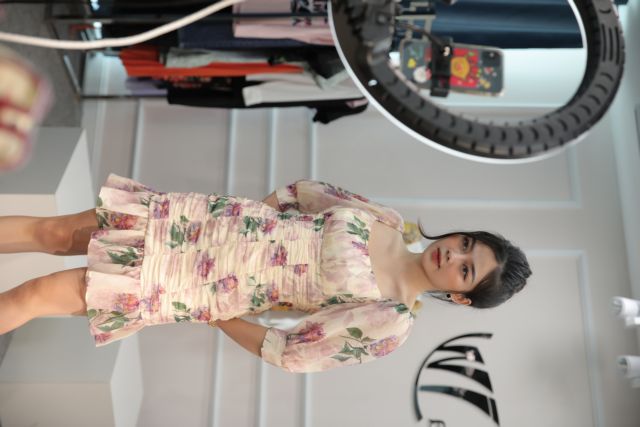 Life & Style
Life & Style

Attentively watching the model presenting a new collection in a livestream of popular fashion brand IVY moda on her mobile, Nguyễn Hương Thảo from time to time types in her questions on a product she likes.
Lê Hương
Attentively watching a model presenting a new collection by popular fashion brand IVY moda on her mobile, Nguyễn Ngọc Thảo, from time to time, types in a question about a product she likes.
For many months during the pandemic, Thảo has indulged in the habit of watching daily live streams on the weekend and buying clothes from her favourite brands instead of going out to shop.
“I think live streaming is more effective for busy women like me,” she told Việt Nam News. “I don’t have to go out while the virus is circulating yet I can still buy clothes for me, my husband, and my children and access special offers. The models provide sufficient information on the products.”

|
| A model presents a new design at a livestream of IVY moda. Courtesy Photo of IVY moda |
Thảo is among hundreds of women, who are frequent online customers of the 16-year-old Vietnamese fashion brand that produces a range of clothes for women, men, and kids. The company has 80 stores in 42 localities throughout the country.
According to Lê Thị Ngọc Linh, CEO of IVY moda, the company’s board has a fairly basic strategy for the pandemic period: “active balance”. Loosely, the whole production line and sales platform have been made as agile as possible to react quickly to new developments in the pandemic.
In May and June of this year, the company’s offline sales halved compared to the same period last year. This resulted in a decrease in income of 40 per cent.
“Our production unit is designed to ensure safe production amid the pandemic,” Linh told Việt Nam News. “This is especially important when our workers have to stay inside our factory in the northern province of Hưng Yên in case the locality goes into lock down.”
“We have online selling experience already,” Linh goes on. “This year live streams have been promoted to twice a day and are now twice as long. This has resulted in a 200 per cent increase in orders against the same time last year. Live streams have also urged more customers to visit our stores. We have recorded a 30 per cent increase in new customers thanks to live streams.”
Linh said digital transformation has been crucial to the enterprises response to COVID-19.
“Beside promoting online sale, we joined Shopee and Lazada. If the pandemic lasts longer, we will be forced to close some ineffective stores to save expenses,” Linh said.
IVY moda is among thousands of fashion companies that have gone online to adapt the pandemic.
“Though ensuring business can continue while the pandemic is ongoing, we still need to be very careful,” said Trần Quang Thắng, Rector of HCM City Economics and Management Institute. “Direct goods shipping should still be promoted in combination with the traditional methods of selling.”
According to new figures from the General Statistics Office, in the first five months of this year, over 59,000 enterprises ceased operations temporarily or are pending bankruptcy. This is a 23 per cent increase against the same period last year. On average, nearly 12,000 enterprises have withdrawn from the market each month since the pandemic began.
At a recent workshop hosted by RMIT University on digital transformation in fashion enterprises, experts held that domestic fashion brands have unique opportunities to develop their business while responding to COVID-19.
Nina Yiu, head of the Fashion Enterprise Management subject at the university said the future of shopping is online and enterprises need to adapt to that reality.
JPMorgan forecasts the number of social network users in Việt Nam will increase to 50.9 million in 2021, against 43.8 million users in 2017. Mobile trading in Việt Nam is also expected to increase to US$10.2 billion in 2023 with annual growth year-on-year of 18.6 per cent, she said.
In a survey among Vietnamese city dwellers by the university, over 87 respondents said they engaged in online shopping and clothes are among the most popular online goods.

|
| An IVY moda store. The company has 80 stores all over the country. Courtesy Photo of IVY moda |
Yiu further said fashion brands can use new technology to create digital designs and improve their production processes.
“Domestic brands should diversify their products and markets, rather than basing their range on a single genre of products,” Yiu said.
“They should go to great lengths to understand their target customers and markets to develop strategies that encourage repeat customers,” she added.
Digital transformation to survive
IVY moda has developed a mobile app that offers more friendly ways of communication and selling goods for the past three years.
The app has also replaced physical member cards.
“Thanks to the app, we have experienced an increase of 20 per cent in online customers and improved the effectiveness of our remarketing programme to offer special treats to frequent customers,” Linh said.
The company has also implemented pioneer radio-frequency identification in fashion. This technology is used to track goods from the production line to its stores reducing the time it takes for goods to reach the end consumer and subsequently reducing the amount of left over stock.
K’s Closet, a popular kid’s fashion brand, has considered the pandemic a challenge and a driving force for the brand to develop and to find new opportunities.
“The years 2020 and 2021 may be the period in which the brand has made its biggest ever digital transformation,” said Bùi Thùy Trang, Deputy Head of the K’s Closet’s Marketing Department.
“We bought a digital printing machine to offer more beautifully printed designs. We also expanded our sales channels incorporating popular web pages like Shopee and Lazada. We’ve also been offering more live streams on our fan pages as well as posting new products on our website.”

|
| Models in designs by K's Closet. Courtesy Photo of K's Closet |
Trang said the company plans to do more research on new social channels to get closer to more customers.
Established in 2015, K’s Closet now runs 34 stores throughout the country.
The company offers new designs every week to make sure they are on top of the latest trends in kid’s fashion. Everyday basics, vintage, and preppy looks, have been among the most popular styles among kids as small as one year old up to early-teens.
“New technology has offered us various ways to digitally transform. For example, e-commerce providers, websites, social pages, apps, and software,” Trang said. “The ingredients are readily available and our customers are hungry, so why shouldn’t we create wonderful dishes for them?”
Linh foresees that the market will remain the same till the end of this year as the pandemic is still not yet under control. This could have serious consequences that affect the lives of production workers and sales staffs alike.
“Our priority is assuring jobs for our staff while maintaining our ready-to-fight spirit. Being more agile in producing and selling our products will be key,” Linh said. VNS

|
| K's Closet offers various styles for children from 1 to 14 years old. Courtesy Photo of K's Closet |

|




